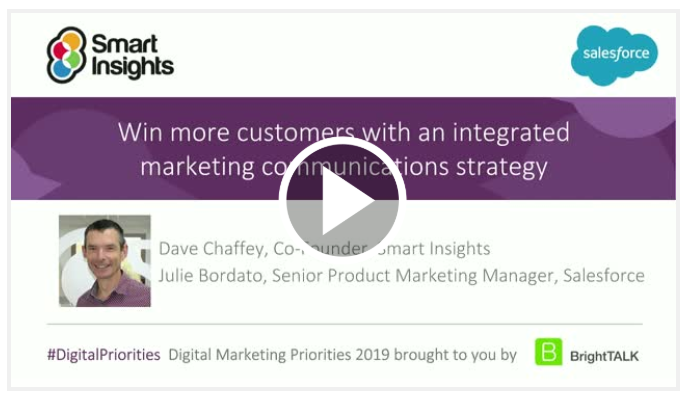Something strange happened in B2B marketing recently: customers stopped tolerating second-rate experiences.
Of course, it wasn’t a simple isolated shift but a whole load of factors combining over time. Experiences we are exposed to in our personal lives blend into our working lives. So regardless of whether you’re buying as a consumer or on behalf of your company, your best experience anywhere becomes your expectation everywhere.
That’s what Julie Bordato, Senior Product Marketing Manager at Salesforce, noted in our recent webinar in conversation with Dr Dave Chaffey, Co-Founder of Smart Insights.
They discussed these changing customer expectations and highlighted that in order to continue delighting customers, brands need to move forward with an integrated marketing communications and automation strategy.
You can tune in to the on-demand webinar, Integrate and automate your way to winning more customers, or read on for an overview of the topics covered.
The Age of the Connected Customer
Salesforce’s Julie Bordato sets the scene and talks about how the commoditisation of products led brands to differentiate on service instead. And now, in the Age of the Connected Customer, the shift has continued, with experience becoming the new competitive currency.
81% of brands say they now compete on experiences – which is no surprise, when two thirds of customers say they’d pay more for better experiences.
A foundation of trust
Julie goes on to discuss how earning trust has become a top priority for brands looking to build experiences. When you’re trying to go from a one-size-fits-all marketing approach to one that’s frictionless and personalised, it will all be in vain if the customer perceives you’re just trying to upsell them a more expensive product.
To avoid making customers feel like just another transaction, the frictionless experience that brands should be delivering guides customers through a purchase path with consistent messaging across sales, marketing and all other customer-facing departments.
“It takes a village to create this kind of experience” according to Julie, so it requires what she calls an organisational memory – one that your teams can draw on and contribute to at all stages from pre-sale to post-sale. It’s here that customer trust can deepen until they become in effect an extension of your marketing department, recommending the products they’ve mastered.
Marketing’s measurable impact on sales
Trust isn’t just a fluffy nice-to-have. Brands considered to be “trusted advisors” by their customers enjoy a 20% higher win rate than “approved vendors”.
For many brands, it’s the marketing team that kick-starts everything. And every marketing touchpoint has a chance to build trust and improve their product mastery along the following journey:
Guide customers to the right solutions
Anticipate customer adoption needs
Accelerate product mastery
Growth through recommendations
Foster brand loyalty
Stepping up to deliver
So how do you go about adopting a planned approach to customer journey-building? That’s where Dr Dave Chaffey from Smart Insights inserts some practical tips.
Dave outlines a three-stage model: Opportunity, Strategy, Action. In the first step, the key is to show your stakeholders what’s possible when you get the buyer journey right. A good way to do this is to reveal the complexity of touchpoints and technologies at play in any given omni-channel buyer journey.
One model to help assess this is the RACE framework (Reach, Act, Convert, Engage). Dave uses this to map multiple paid, owned, earned and experience touchpoints.
He then goes on to list the steps you can take to start optimising the buyer journey, as well as a few timely reminders.
These include:
Audit your email marketing and automation capabilities.
The importance of ongoing cross-channel nurturing through increasingly complex buying journeys.
Model and report on pipeline.
Do some lead scoring that’s both implicit – based on behavioural data – and explicit – based on declared profile-based data.
Dave shares many mind tools, including one for testing the maturity of your content marketing work: Does it cover journey mapping? Is it personalised to different personas? Is it tailored to your different services? And how well does it align with sales activity? Tune in to the webinar to see these in detail.
The rise of AI in B2B
To wrap up, Julie shares some interesting statistics, for example, AI usage has really taken off among B2B marketing teams – growing by 23% in the past year.
It’s early days so there’s no dominant application, but AI is being used for things like enhancing online experiences with offline data, driving real-time next best offers, improving customer segmentation and more.
During the audience Q&A, the presenters shared tips on how to get started building marketing automation maturity from the lowest levels. To relate this back to the real world, Julie shared an example of how Zoom fuels its smarter customer journeys with the help of the Salesforce platform.
Tune in and skill up
Get started on how to stand up your own integrated email and marketing automation strategy by checking out the full on-demand webinar here: Integrate and automate your way to winning more customers.
And check out the complimentary report here: ‘Win more customers with an integrated marketing communications and automation strategy.’








